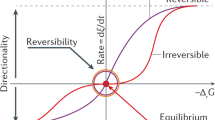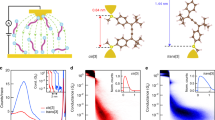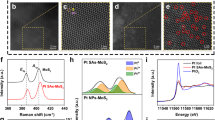Abstract
It is often thought that the ability to control reaction rates with an applied electrical potential gradient is unique to redox systems. However, recent theoretical studies suggest that oriented electric fields could affect the outcomes of a range of chemical reactions, regardless of whether a redox system is involved1,2,3,4. This possibility arises because many formally covalent species can be stabilized via minor charge-separated resonance contributors. When an applied electric field is aligned in such a way as to electrostatically stabilize one of these minor forms, the degree of resonance increases, resulting in the overall stabilization of the molecule or transition state. This means that it should be possible to manipulate the kinetics and thermodynamics of non-redox processes using an external electric field, as long as the orientation of the approaching reactants with respect to the field stimulus can be controlled. Here, we provide experimental evidence that the formation of carbon–carbon bonds is accelerated by an electric field. We have designed a surface model system to probe the Diels–Alder reaction, and coupled it with a scanning tunnelling microscopy break-junction approach5,6,7. This technique, performed at the single-molecule level, is perfectly suited to deliver an electric-field stimulus across approaching reactants. We find a fivefold increase in the frequency of formation of single-molecule junctions, resulting from the reaction that occurs when the electric field is present and aligned so as to favour electron flow from the dienophile to the diene. Our results are qualitatively consistent with those predicted by quantum-chemical calculations in a theoretical model of this system, and herald a new approach to chemical catalysis.
This is a preview of subscription content, access via your institution
Access options
Subscribe to this journal
Receive 51 print issues and online access
$199.00 per year
only $3.90 per issue
Buy this article
- Purchase on Springer Link
- Instant access to full article PDF
Prices may be subject to local taxes which are calculated during checkout




Similar content being viewed by others
References
Meir, R., Chen, H., Lai, W. & Shaik, S. Oriented electric fields accelerate Diels–Alder reactions and control the endo/exo selectivity. ChemPhysChem 11, 301–310 (2010)
Gryn’ova, G., Marshall, D. L., Blanksby, S. J. & Coote, M. L. Switching radical stability by pH-induced orbital conversion. Nature Chem. 5, 474–481 (2013)
Gryn’ova, G. & Coote, M. L. Origin and scope of long-range stabilizing interactions and associated SOMO–HOMO conversion in distonic radical anions. J. Am. Chem. Soc. 135, 15392–15403 (2013)
Shaik, S., de Visser, S. P. & Kumar, D. External electric field will control the selectivity of enzymatic-like bond activations. J. Am. Chem. Soc. 126, 11746–11749 (2004)
Xu, B. & Tao, N. J. Measurement of single-molecule resistance by repeated formation of molecular junctions. Science 301, 1221–1223 (2003)
Haiss, W. et al. Measurement of single molecule conductivity using the spontaneous formation of molecular wires. Phys. Chem. Chem. Phys. 6, 4330–4337 (2004)
Haiss, W. et al. Precision control of single-molecule electrical junctions. Nature Mater. 5, 995–1002 (2006)
Sini, G., Maitre, P., Hiberty, P. C. & Shaik, S. S. Covalent, ionic and resonating single bonds. J. Mol. Struct. Theochem 229, 163–188 (1991)
Shaik, S., Danovich, D., Wu, W. & Hiberty, P. C. Charge-shift bonding and its manifestations in chemistry. Nature Chem. 1, 443–449 (2009)
Shurki, A., Hiberty, P. C. & Shaik, S. Charge-shift bonding in group IVB halides: a valence bond study of MH3−Cl (M = C, Si, Ge, Sn, Pb) molecules. J. Am. Chem. Soc. 121, 822–834 (1999)
Fischer, H. & Radom, L. Factors controlling the addition of carbon-centered radicals to alkenes—an experimental and theoretical perspective. Angew. Chem. Int. Edn 40, 1340–1371 (2001)
Lai, W., Li, C., Chen, H. & Shaik, S. Hydrogen-abstraction reactivity patterns from A to Y: the valence bond way. Angew. Chem. Int. Edn 51, 5556–5578 (2012)
Warshel, A. et al. Electrostatic basis for enzyme catalysis. Chem. Rev. 106, 3210–3235 (2006)
Hirao, H., Chen, H., Carvajal, M. A., Wang, Y. & Shaik, S. Effect of external electric fields on the C–H bond activation reactivity of nonheme iron–oxo reagents. J. Am. Chem. Soc. 130, 3319–3327 (2008)
Lai, W., Chen, H., Cho, K.-B. & Shaik, S. External electric field can control the catalytic cycle of cytochrome P450cam: a QM/MM Study. J. Phys. Chem. Lett. 1, 2082–2087 (2010)
Fried, S. D., Bagchi, S. & Boxer, S. G. Extreme electric fields power catalysis in the active site of ketosteroid isomerase. Science 346, 1510–1514 (2014)
Klinska, M., Smith, L. M., Gryn’ova, G., Banwell, M. G. & Coote, M. L. Experimental demonstration of pH-dependent electrostatic catalysis of radical reactions. Chem. Sci. 6, 5623–5627 (2015)
Franchi, P., Mezzina, E. & Lucarini, M. SOMO–HOMO conversion in distonic radical anions: an experimental test in solution by EPR radical equilibration technique. J. Am. Chem. Soc. 136, 1250–1252 (2014)
Alemani, M. et al. Electric field-induced isomerization of azobenzene by STM. J. Am. Chem. Soc. 128, 14446–14447 (2006)
Gorin, C. F., Beh, E. S. & Kanan, M. W. An electric field-induced change in the selectivity of a metal oxide-catalyzed epoxide rearrangement. J. Am. Chem. Soc. 134, 186–189 (2012)
Nicolaou, K. C., Snyder, S. A., Montagnon, T. & Vassilikogiannakis, G. The Diels–Alder reaction in total synthesis. Angew. Chem. Int. Edn 41, 1668–1698 (2002)
Paddon-Row, M. N. Investigating long-range electron-transfer processes with rigid, covalently linked donor-(norbornylogous bridge)-acceptor systems. Acc. Chem. Res. 27, 18–25 (1994)
Darwish, N., Paddon-Row, M. N. & Gooding, J. J. Surface-bound norbornylogous bridges as molecular rulers for investigating interfacial electrochemistry and as single molecule switches. Acc. Chem. Res. 47, 385–395 (2014)
Darwish, N. et al. Observation of electrochemically controlled quantum interference in a single anthraquinone-based norbornylogous bridge molecule. Angew. Chem. Int. Edn 51, 3203–3206 (2012)
Darwish, N. et al. Probing the effect of the solution environment around redox-active moieties using rigid anthraquinone terminated molecular rulers. J. Am. Chem. Soc. 134, 18401–18409 (2012)
Darwish, N. et al. Electroactive self-assembled monolayers of unique geometric structures by using rigid norbornylogous bridges. Chemistry 18, 283–292 (2012)
Díez-Pérez, I. et al. Rectification and stability of a single molecular diode with controlled orientation. Nature Chem. 1, 635–641 (2009)
Donhauser, Z. J. et al. Conductance switching in single molecules through conformational changes. Science 292, 2303–2307 (2001)
Claridge, S. A., Schwartz, J. J. & Weiss, P. S. Electrons, photons, and force: quantitative single-molecule measurements from physics to biology. ACS Nano 5, 693–729 (2011)
Tao, N. J. Electron transport in molecular junctions. Nature Nanotechnol. 1, 173–181 (2006)
Acknowledgements
This research was supported by the MINECO Spanish National Project (no. CTQ2012-36090) and an EU Reintegration Grant (FP7-PEOPLE-2010-RG-277182), and by resources provided at the NCI National Facility systems at the Australian National University through the National Computational Merit Allocation Scheme, supported by the Australian Government. N.D. thanks the European Union for a Marie Curie IIF Fellowship. I.D.-P. thanks the Ramon y Cajal program (MINECO, no. RYC-2011-07951) for financial support. S.C. thanks the University of Wollongong for a Vice Chancellor Fellowship, and the Australian National Fabrication Facility for financial support. A.C.A. thanks the Spanish Ministerio de Educación for an FPU fellowship. M.L.C acknowledges financial support from the Australian Research Council (ARC) and an ARC Future Fellowship, and discussions with M. Banwell. We also acknowledge funding from the ARC Centre of Excellence Scheme (project no. CE 140100012).
Author information
Authors and Affiliations
Contributions
A.C.A., N.D. and I.D.-P. carried out the STM experiments and analysed the data. N.J.B. and N.L.H. performed the quantum-chemical modelling, with input from M.L.C. S.C. carried out the synthetic work. All authors conceived the work, and designed and discussed the experiments. M.L.C. and S.C. wrote the manuscript, with substantial contributions from the other authors.
Corresponding authors
Ethics declarations
Competing interests
The authors declare no competing financial interests.
Supplementary information
Supplementary Information
This file contains Supplementary Methods, Supplementary Text and Data, Supplementary Figures, Supplementary Tables and additional references (see Contents for more details). (PDF 19898 kb)
Rights and permissions
About this article
Cite this article
Aragonès, A., Haworth, N., Darwish, N. et al. Electrostatic catalysis of a Diels–Alder reaction. Nature 531, 88–91 (2016). https://doi.org/10.1038/nature16989
Received:
Accepted:
Published:
Issue Date:
DOI: https://doi.org/10.1038/nature16989
This article is cited by
-
Total variation denoising-based method of identifying the states of single molecules in break junction data
Discover Nano (2024)
-
Electrofreezing of liquid water at ambient conditions
Nature Communications (2024)
-
Electrostatic catalysis of a click reaction in a microfluidic cell
Nature Communications (2024)
-
Electric-field-controlled highly regioselective thiocyanation of N-containing heterocycles
Science China Chemistry (2024)
-
Single-cluster electronics using metallic clusters: Fabrications, regulations, and applications
Nano Research (2024)
Comments
By submitting a comment you agree to abide by our Terms and Community Guidelines. If you find something abusive or that does not comply with our terms or guidelines please flag it as inappropriate.



